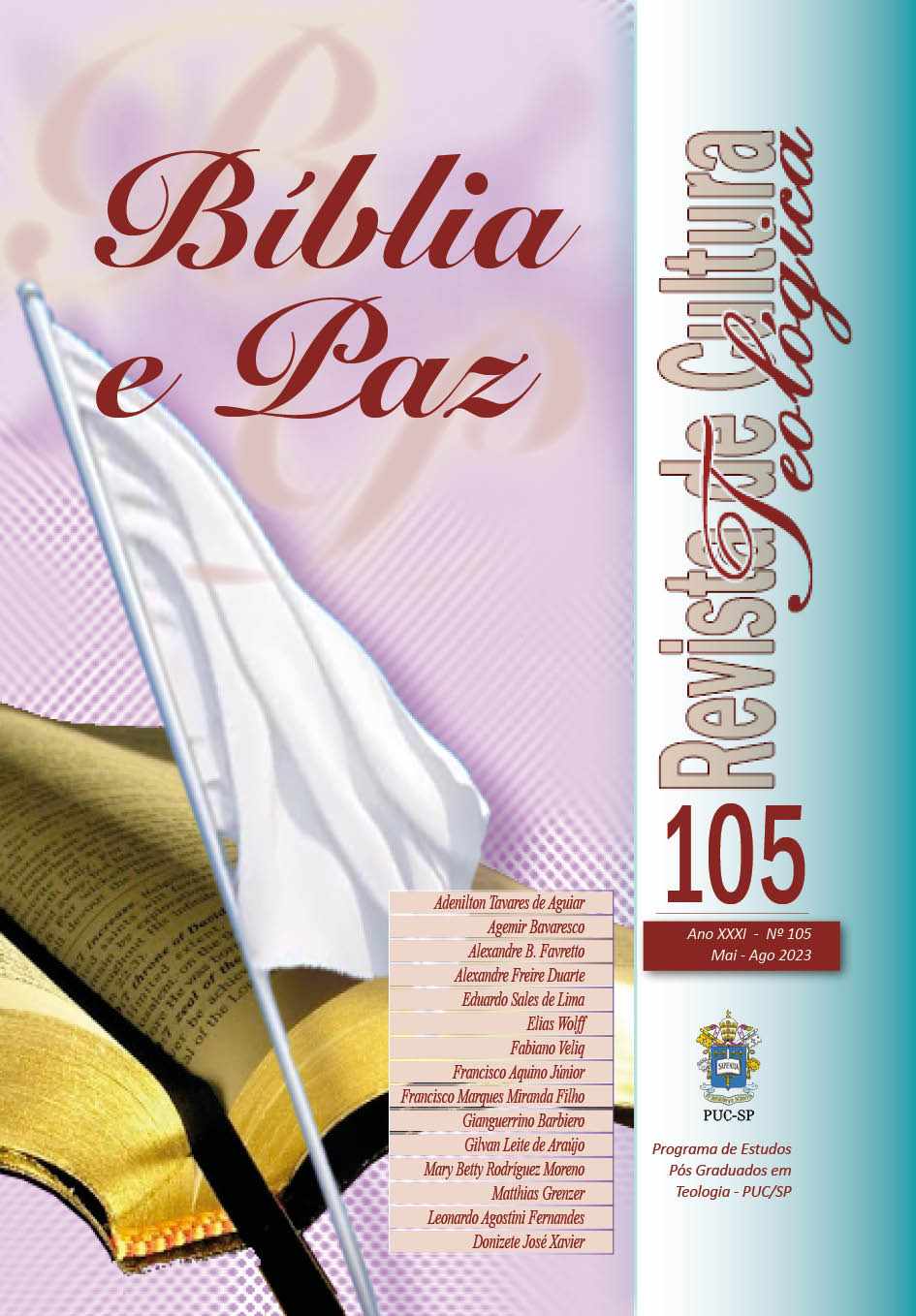Gafanhotos na Bíblia Hebraica
Suas dimensões socioambientais e teológicas
DOI:
https://doi.org/10.23925/rct.i105.61571Keywords:
Locust, Bible and ecology, green reading, socioenvironmental dimensionsAbstract
Biblical literature, besides reflecting on God and the human being, thinks deeply about non-human beings, that is, the air, the water, the soil, the heat, the plants, and the animals. At times it admires the beauty of these beings and the functioning of the ecosystem, and at other times it contemplates those forces amid nature that suddenly threaten the human being's survival. One glimpses how a specific purpose accompanies the existence of each being. Thus, nature, understood as divine creation, becomes God's word. That is, the abiotic beings, flora and fauna allow experiences and gain symbolic connotations that bring human beings closer to the mystery of life and, with it, to the hope that God will save his creation. In this investigation, the insect commonly called locust or grasshopper is targeted. What does the Hebrew Bible, by mentioning it fifty-five times, bring to a socio-environmental and/or theological reflection to its readers?
References
ACHTEMEIER, Elizabeth. I dodici profeti (Parte seconda: Naum, Abacuc, Sofonia, Aggeo, Zaccaria, Malachia). Torino: Claudiana, 2007.
ALONSO SCHÖKEL, Luis; SICRE DIAZ, José Luis. Profetas I – Isaías, Jeremias. São Paulo: Paulinas, 1988.
BALZARETTI, Claudio. Le storiografie della Bibbia. In: BORGONOVO, Gianantonio e collaboratori. Torah e Storiografie dell’Antico Testamento. Leumann (Torino): ELLEDICI, 2012, p. 317-390.
BOROWSKI, Oded. Agriculture and Agricultural Tools. In: BERLEJUNG, Angelika (ed.). Encyclopedia of Material Culture in the Biblical World: A New Biblisches Reallexikon. Tübingen: Siebeck, 2022, p. 1-18.
BRAULIK, Georg. Deuteronomium II: 16,18–34,12. Würzburg: Echter, 1992.
CROATTO, J. Severino. Isaías. Vol. I: 1–39. O profeta da justiça e da fidelidade. Petrópolis/São Paulo/São Leopoldo: Vozes/Metodista/Sinodal, 1989.
DALMAN, Gustaf. Arbeit und Sitte in Palästina: Der Ackerbau. V. II. Jerusalém/Tübingen: SLM Press/Tobislib, 2013.
DEYSEL, Lesley Claire Frances. Animal Names and Categorization in the Hebrew Bible: A Textual and Cognitive Approach. Tese doutoral. Pretoria: University of Pretoria, 2017. https://repository.up.ac.za/bitstream/handle/2263/62675/Deysel_Optimising_2017.pdf?sequence=1&isAllowed=y
DIETRICH, Walter; ARNET, Samuel (eds.). Konzise und aktualisierte Ausgabe de Hebräischen und Aramäischen Lexikons zum Alten Testament. Leiden: Brill, 2013.
FERNANDES, Leonardo Agostini. O Anúncio do Dia do Senhor. Significado profético e sentido teológico de Joel 2,1-11. São Paulo: Paulinas, 2014.
FRANCISCO, Papa. Carta Encíclica Laudato Si´. Sobre o cuidado da casa comum. São Paulo: Paulinas, 2015.
GILBERT, Allan S. The Native Fauna of the Ancient Near East. In: COLLINS, Billie Jean (ed.). A History of the Animal World in the Ancient Near East. Leiden: Brill, 2002, p. 3-75.
GRENZER, Matthias. Locusts: Econarrativities in Exodus 10:1-20. In: Stellenbosch Theological Journal, 2023 (no prelo).
HERTZBERG, Hans Wilhelm. Giosué, Giudici, Rut. Brescia: Paideia, 2001.
HIEKE, Thomas. Levitikus 1–15. Freiburg: Herder, 2014.
JAPHET, Sara. 2 Chronik. Freiburg: Herder, 2003.
KAISER, Otto. Isaia (capitoli 13–39). Brescia: Paideia, 2002.
KEEL, Othmar. Jahwes Entgegnung an Ijob: Eine Deutung von Ijob 38–41 vor dem Hintergrund der zeitgenössischen Bildkunst. Göttingen: Vandenhoeck & Ruprecht, 1978.
LOHFINK, Norbert. Kohelet. 2. Ed. Würzburg: Echter, 1980.
KLEIN, Ernest. A Comprehensive Etymological Dictionary of the Hebrew Language for Readers of English. Jerusalem: Carta, 1987.
NELSON, Richard D. First and Second Kings. Louisville: John Knox Press, 1987.
OTTO, Eckart. Deuteronomium 23,16–34,12. Freiburg: Herder, 2017.
PINTO, Sebatiano. Provérbios: Introdução, tradução, comentário. São Paulo: Loyola, 2018.
RADNER, Karen. Fressen und gefressen werden. Heuschrecken als Katastrophe und Delikatesse im Alten Vorderen Orient. In: Die Welt des Orients, v. 34, p. 7-22, 2004.
RIEDE, Peter. Im Spiegel der Tiere: Studien im Verhältnis von Mensch und Tier im alten Israel. Freiburg/Göttingen: Universitätsverlag/Vandenhoeck & Ruprecht, 2002.
SCHROER, Silvia. Die Tiere in der Bibel: Eine kulturgeschichtliche Reise. Freiburg: Herder, 2010.
SCHWIENHORST-SCHÖNBERGER, Ludger. Kohelet. Freiburg: Herder, 2004.
SCHWIENHORST-SCHÖNBERGER, Ludger. Nicht im Menschen gründet das Glück (Koh 2,24): Kohelet im Spannungsfeld jüdischer Weisheit und hellenistischer Philosophie. Freiburg: Herder, 1994.
SIMIAN-YOFRE, Horacio. Amos. Milano: Paoline, 2002.
SILVA, Valmor da. Deus ouve o clamor de seu povo: Teologia do êxodo. São Paulo: Paulinas, 2004.
STALLMAN, Robert C. אַרְבֶּה. In: VANGEMEREN, Willem A (org.). Novo Dicionário Internacional de teologia e Exegese do Antigo Testamento (Volume 1). São Paulo: Cultura Cristã, 2011, p. 479-483.
STAUBLI, Thomas. Die Bücher Levitikus, Numeri. Stuttgart: Katholisches Bibelwerk, 1996.
VÍLCHEZ LÍNDEZ, José. Eclesiastes ou Qohélet. São Paulo: Paulus, 1999.
WEISER, Artur. Geremia (capitoli 25,15–52,34). Brescia: Paideia, 1987.
WESTERMANN, Claus. Isaia (capitoli 40–66). Brescia: Paideia, 1978.
ZENGER, Erich; HOSSFELD, Frank-Lothar. Psalmen 51–100. Freiburg: Herder, 2000.
Published
How to Cite
Issue
Section
License
Copyright (c) 2023 Revista de Cultura Teológica

This work is licensed under a Creative Commons Attribution-NonCommercial-NoDerivatives 4.0 International License.
Os autores concedem à revista todos os direitos autorais referentes aos trabalhos publicados. Os conceitos emitidos em artigos assinados são de absoluta e exclusiva responsabilidade de seus autores.

